High Impendance Electroporation
Methodology:
- The morphological structure of all fungi, bacteria and viral cells is similar.
- It entails a thin membrane that is surrounded by a suspension of a cytoplasmic fluid, in which the organism’s cellular machinery are suspended.
- The structure of membranes is heterogeneous and complex, and acts as a barrier for a living cytoplasm to its extracellular environment.
- The robustness of biological membranes is remarkable, and it acts as a chemical, structural, as well as electrical barrier. Still, a biological membrane is able to conduct a cell’s various transmembrane metabolic processes of the cell. Viability of a cell dependent on its barrier function, in addition to membrane integrity.
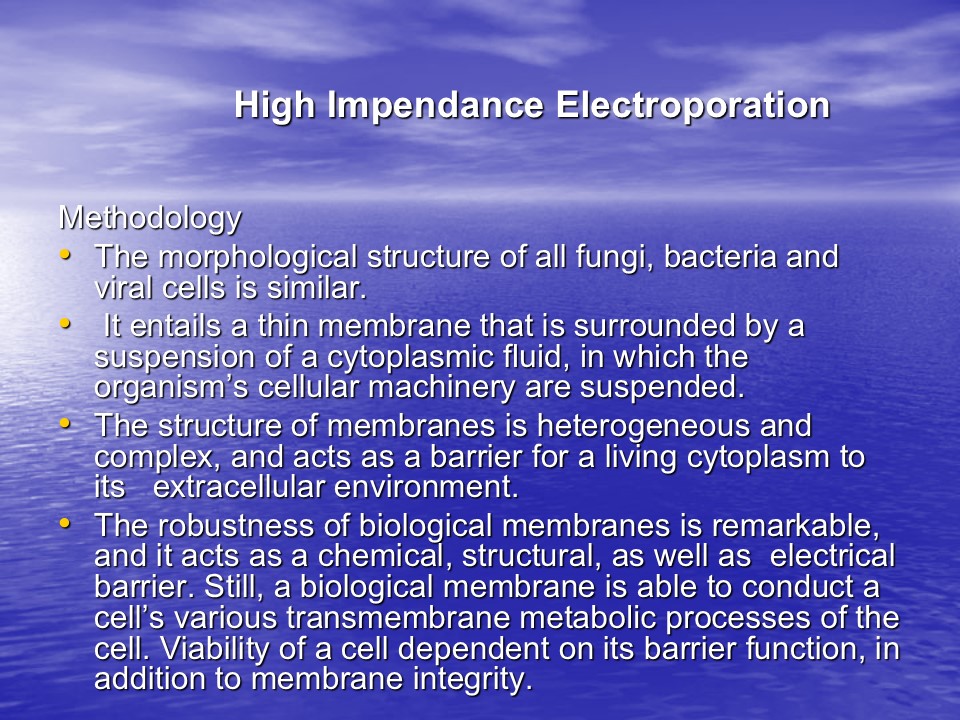
HIE device (Overview)
- May-Ruben Technologies, Inc. (MRT) is a corporation in Calgary, Alberta, that is privately owned. MRT also has offices in Las Vegas, Nevada. At the moment, MRT is involved in the development of a new technique and device to produce High Impedance Electroporation (HIE) device for killing microorganisms within fluids.
- Most liquid foods contains pathogenic microorganism that requires chlorination or pasteurization before consumption. Chlorination and pasteurization finds application in developed societies due to their significant health benefits.
- The two processes signify a major environmental and economic burden. Globally, annual cost of thermal pasteurization of milk approximates two billion dollars.
- As a thermal process, pasteurization involves a rapid increase of the temperature of a liquid food for a short time, followed by a rapid coolly of the same to suitable temperature for storage and transportation purposes.
- As a chemical process, chlorination finds application mainly in the manufacture of potable water.
- Both processes kill or otherwise inactivate a fraction of the pathogens. Rates of inactivation of organisms by both techniques approximately 99.99% or greater.
- Owing to significant health benefits associated with chlorination and pasteurization, they find universal application in developed economies.
- Nevertheless they represent an important environment and economic burden.
- Globally, thermal pasteurization of milk, a liquid food, consumes approximately two billion dollars annually, worth of energy cost.
- MRT device is an efficient non-chemical, non-thermal pasteurizer. MRT provides significant economic benefits over conventional pasteurization (potentially lowers energy requirements by up to 99 percent).
- MRT device could find application in drinking water and liquid food treatments in underdeveloped regions.
- MRT device may use solar energy to pasteurize liquids in remote areas.
- Underlying technology.
- Electroporation: electric field application to a living cell (s) to cause membrane lysis and eventually, death of the cell(s).
- MRT device relies on High Impedance Electroporation (HIE) to causes electroporation of suspended organisms.
- Energy consumption nominal, no side effects.

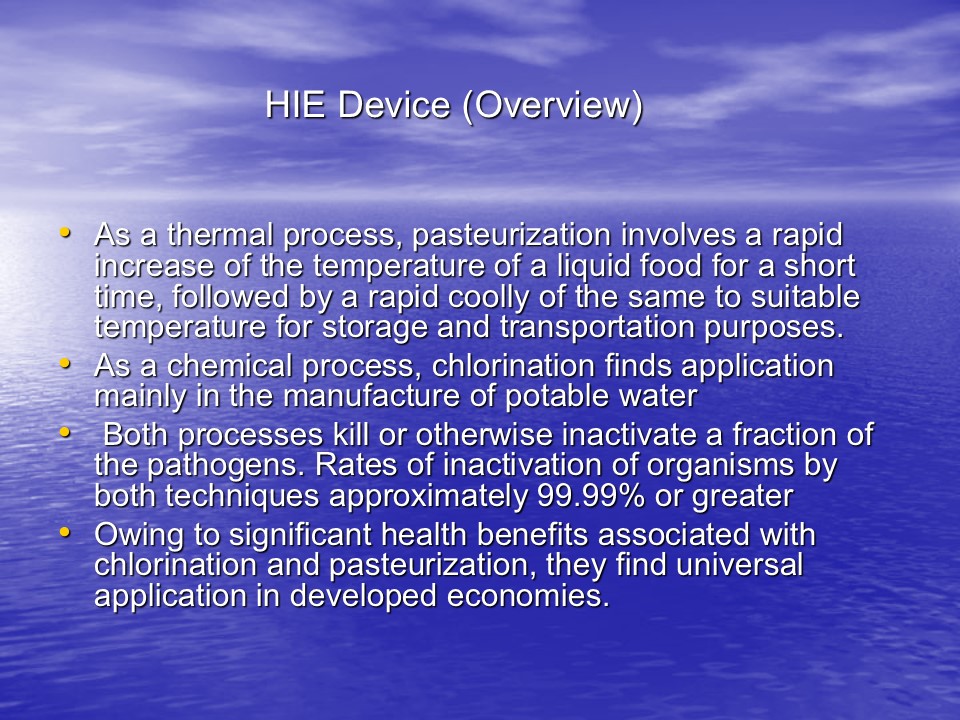
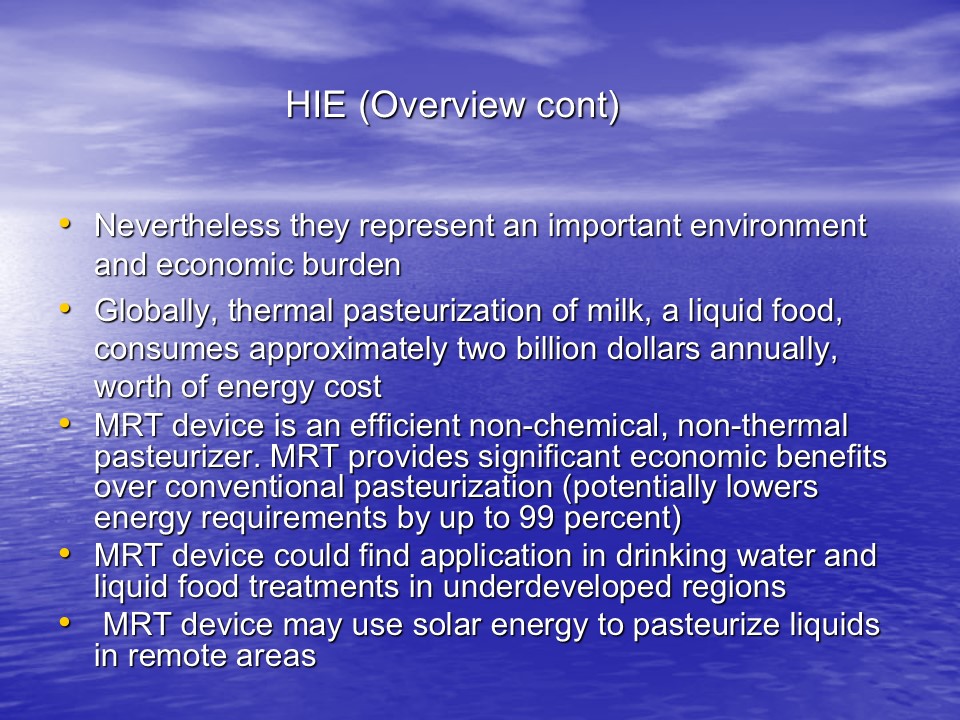
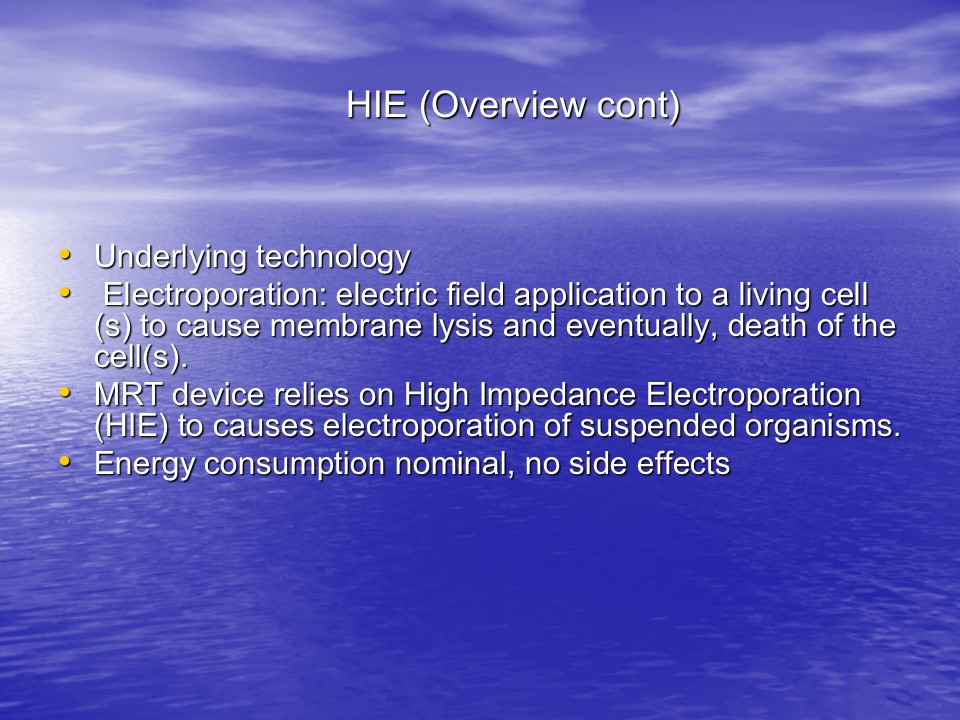
HIE Methodology
- Application of an electric field of sufficient duration and intensity to a living cell severely disturbs membrane integrity, leading to mechanical perforation, lysis, and death (electroporation process).
- Electroporation divided into two classes: irreversible and reversible.
- Reversible electroporation- causes temporal transmembrane effects without death of cell.
- Irreversible electroporation- causes transmembrane effects of sufficient duration, resulting in the death of a cell.
- Transfection is a good example of reversible electroporation, in which the membrane becomes temporarily permeable in both directions.
- After a time, the membrane heals, returning to its pre-electroporation integrity.
- DNA molecules could be introduced to the cytoplasmic machinery via the temporarily open pores during this period of induced permeability
- Irreversible electroporation denotes transmembrane effects of sufficient duration that they eventually lead to cell death.
- Transmembrane effects can lead to the application of electroporation as a means of non-thermal, non-chemical pasteurization.
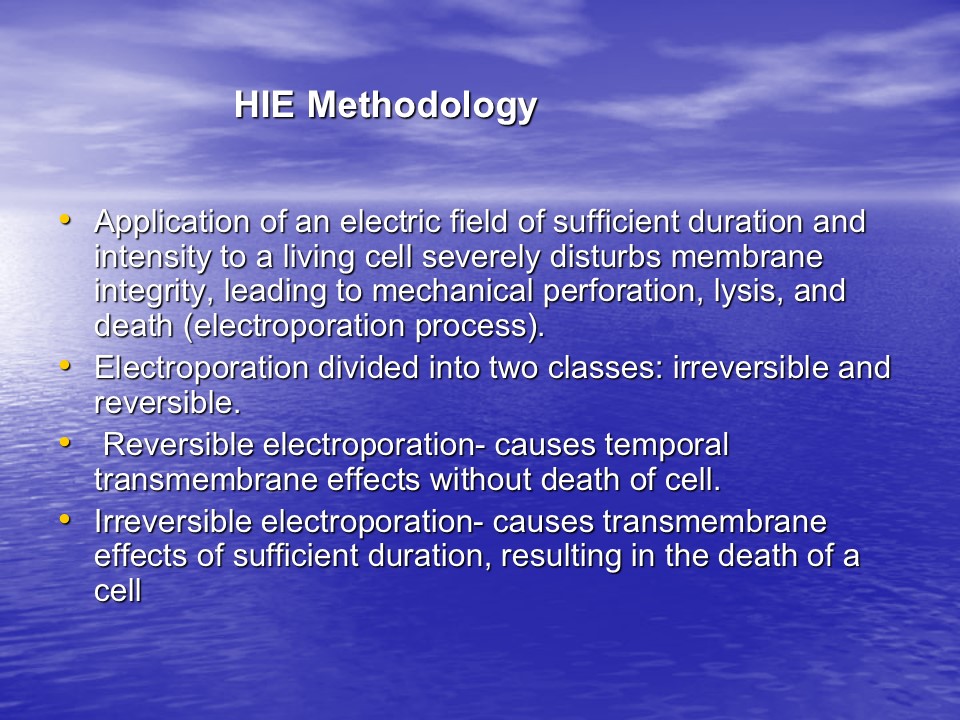

Conventional electroporation devices
Features:
- Unable to upgrade to commercial pasteurization levels.
- Excessive consumption of energy.
- Excessive heating of fluid.
- Hydrogen gas production through electrolysis.
- Conventional electroporation devices made up of a pair of electrically conductive bare -metal electrodes.
- Metal electrodes positioned as opposing flat plates separated by a few millimeters.
- Electrodes immersed in fluid suspension of bacteria.
- Application of voltage causes conduction of electric current across metal electrodes through the suspension fluid. Resulting electric field causes membrane perforation.
- Utilizes Pulsed Electric Field (PEF).
- Pulsing of electric current reduces electrochemical and heating problems.
- Commercial electroporation device realize a five log bacteria reduction at the volumes of production.
- PEF process requires almost same level of energy as thermal pasteurization.
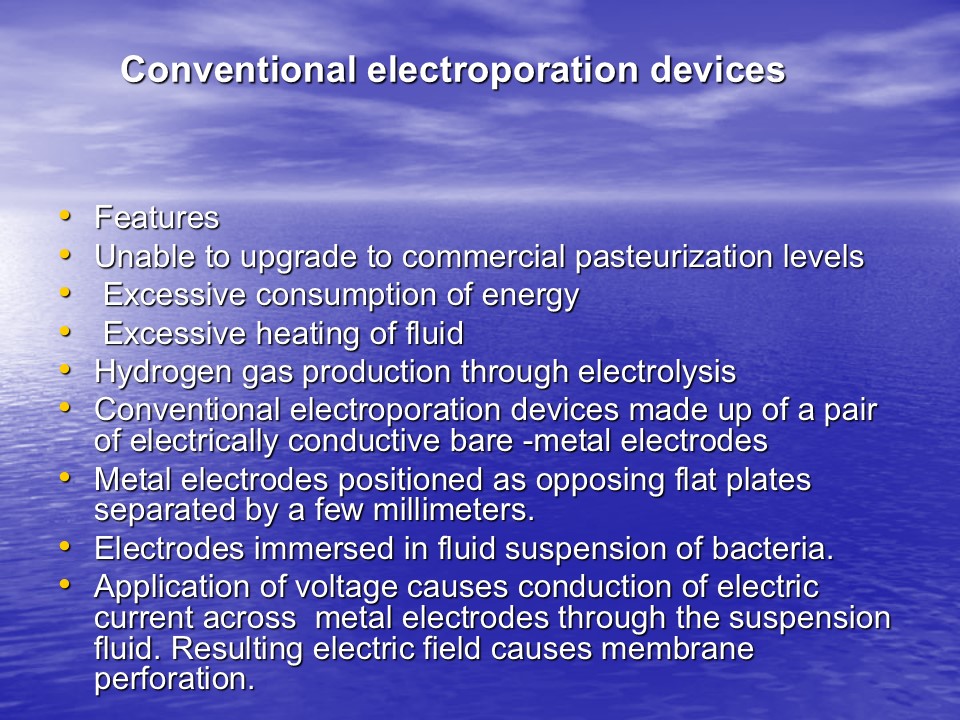

MRT device
Characteristics:
- Utilizes a dielectric barrier between fluid and electrodes, and the metal plates are effectively insulated (High Impedance Electroporation process).
- HIE the principle behind the invention of MRT, and the subsequent application for a patent.
- Electrical insulation of electrodes effectively prevents flow of current through fluid.
- The generated electric field results in the suspended organism being electroporated.
- Energy requirements for HIE are nominal, while adverse side-effects are practically nil.
- HIE has potential to substantially improve on the pasteurization equipment developed by Louis Pasteur during the 1800’s.
- Full realization of lowered consumption of energy of a commercially scaled system would revolutionarize food industry (especially liquid food).
- HIE technology implementation in dairy industry would lead to energy savings of two billion dollars, annually.
- Replacement of the maintenance-intensive and complex system of thermal pasteurization with HIE would enhance energy savings. A replacement of components of thermal pasteurization system with HIE device would also assist in energy savings.
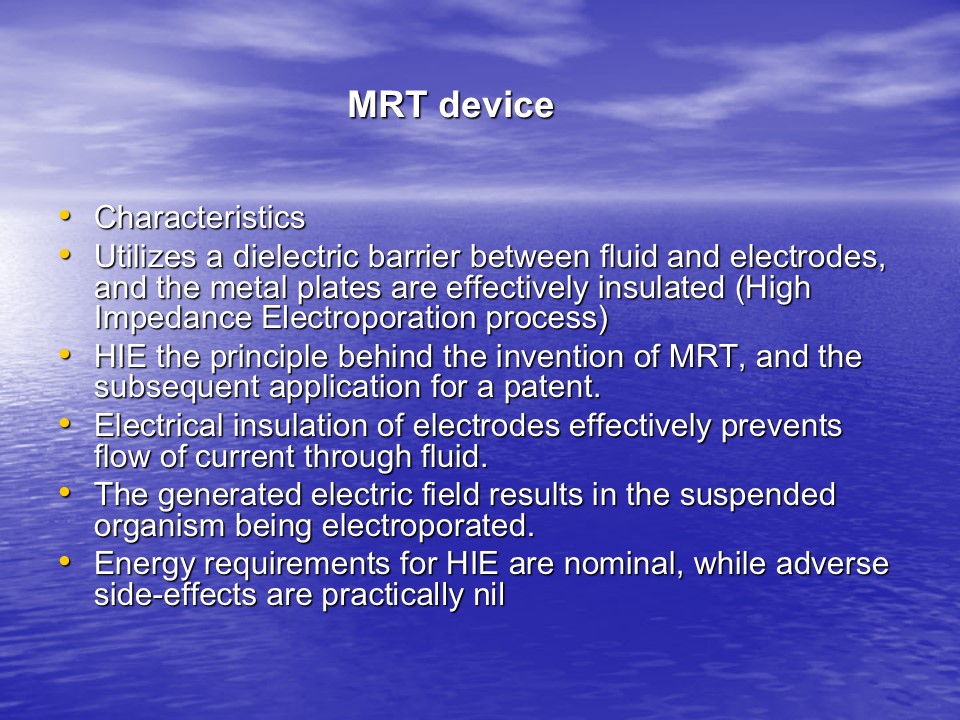
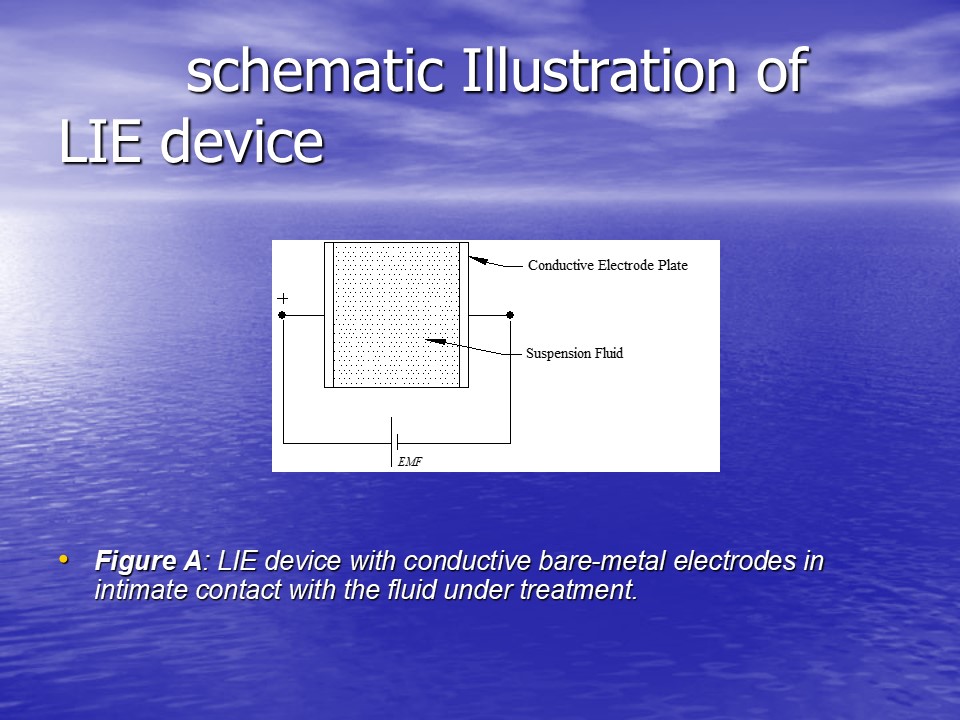
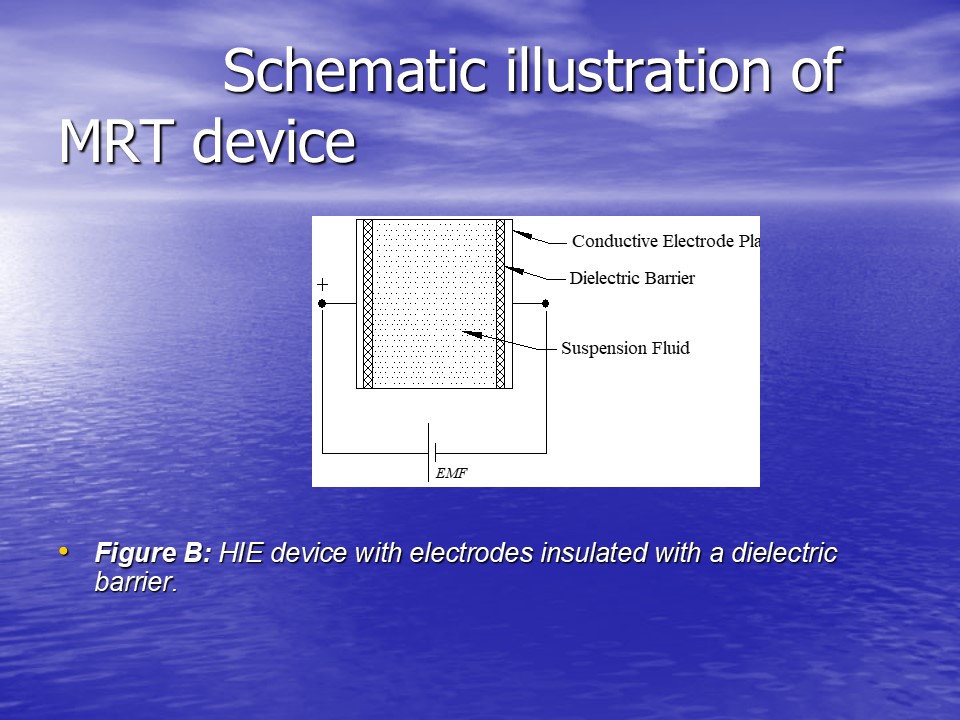
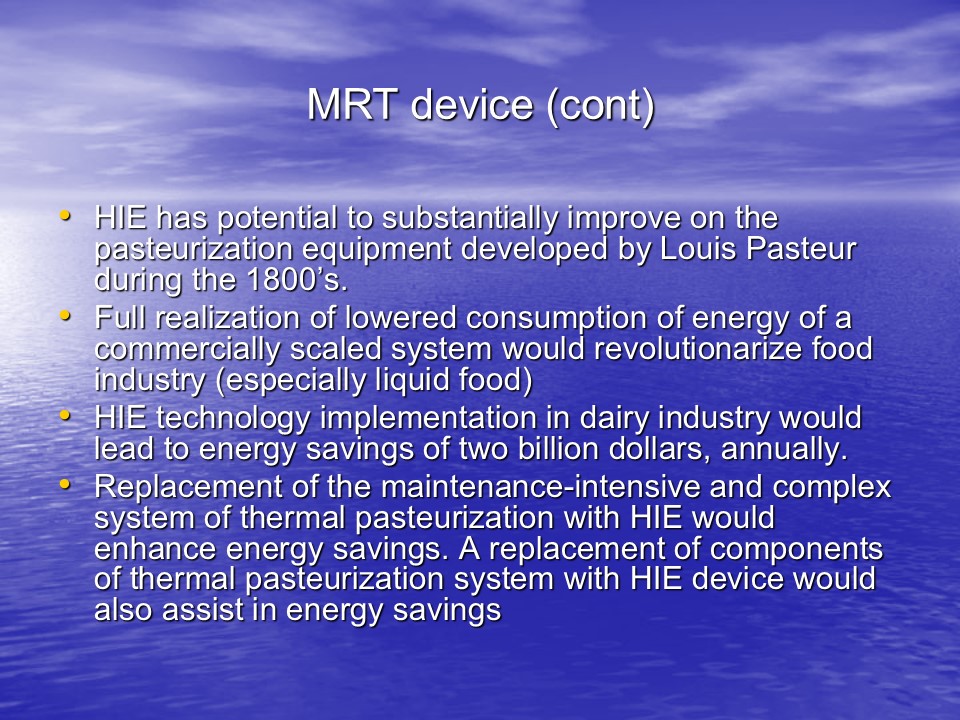
Testing of prototype MRT device
- Proof of prototype:
- An “abatis” device (silver electrodes coated with dielectric ceramic fluid, as well as pathway to transport suspended bacteria through electric field) used.
- High voltage power supply was necessary.
- Test organism- Escherichia coli in a tryptic soy broth suspension. Electric potential applied to abatis in successive steps of 2,000 volts (range: 0 volts to ~10,000 volts). Kill fraction of 30 percent achieved.
- Proof-of-concept prototype proved a success, hence MRT filed patent application.
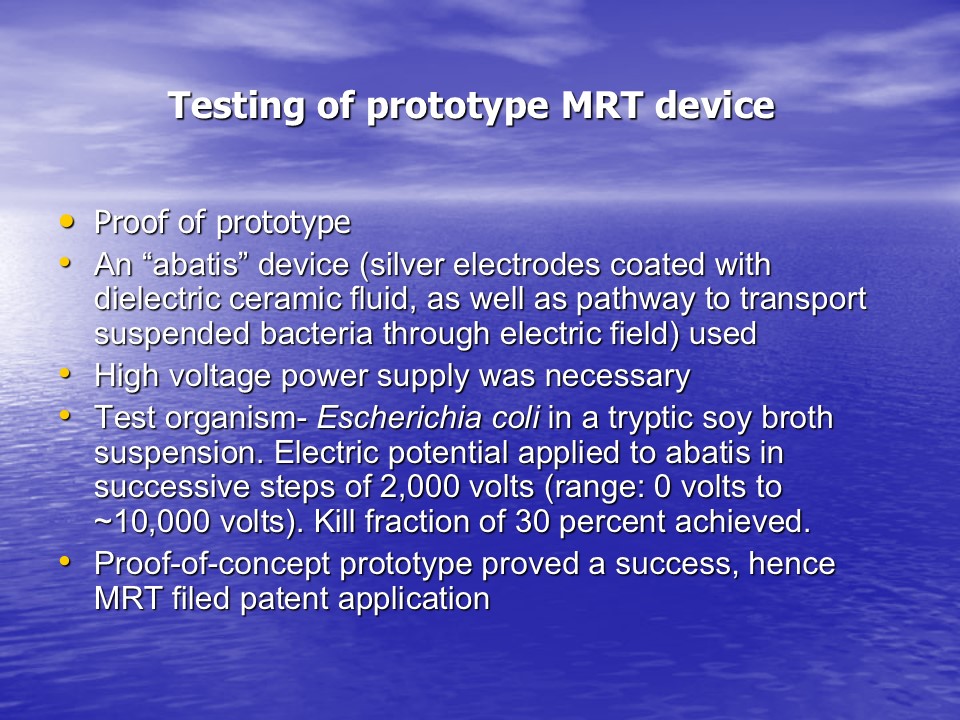
Prototype Development
- Identification and sourcing of a suitable dielectric barrier material, either stock, if available, or custom manufactured.
- Fabrication of electrodes as well the body of the abatis itself, using the selected barrier material.
- Design and construction of a custom power supply or identification and sourcing of an off-the-shelf power supply to drive the device.
- Design and construction of a custom conductivity instrument, a relatively simple endeavor as design of this instrument will follow existing systems but will be modified for this specific purpose.
- Developing the test protocol, assembly of the bench test apparatus, testing, documentation, and conclusive review.

Market Opportunity
Potential Applications:
- Liquid foods: milk, beer, fruit juices, wine, soups.
- Water treatment: household and community portable water, heat exchangers and cooling towers, ship bilges, swimming polls, landscaping water features (man made lakes and fountains).
- Wastewater Treatment- rural households and community systems.
- HVAC Systems for Environmental Air Quality- buildings, Airplanes, Cruise ships.
- Medical: blood plasma, blood banks, individual patients (dialysis type treatment for malaria or hepatitis).
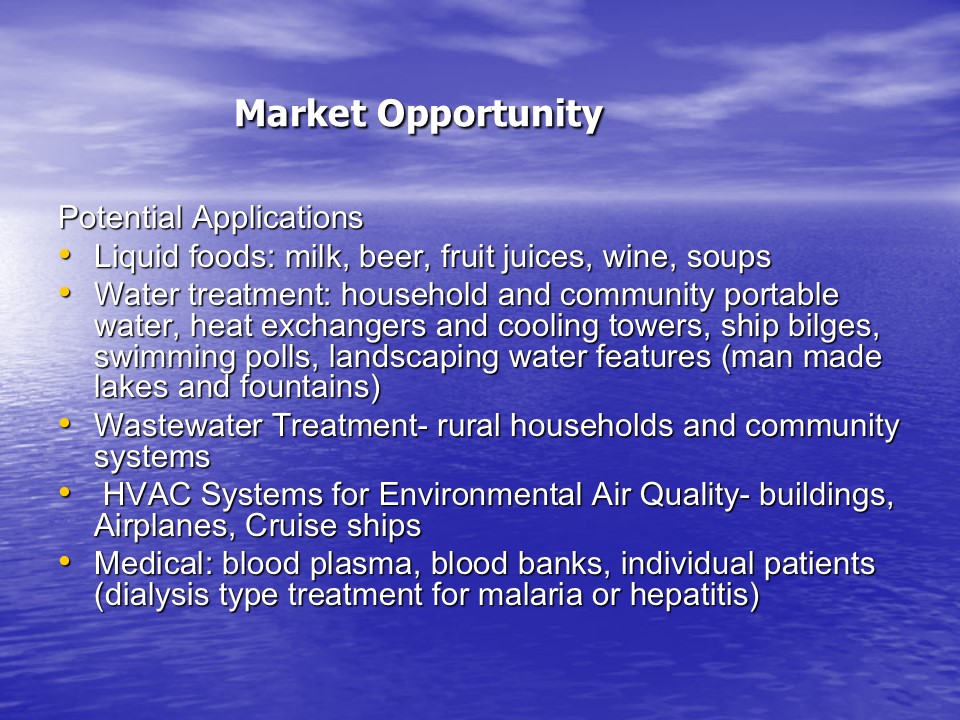
Dairy Industry
- 98 percent of the approximately 580 billion liters of milk produced per year globally, is thermally pasteurized.
- 350 billion liters/year processed using modern pasteurization equipment in developed countries (The National Dairy Council of Canada 6).
- Milk production in China and India growing at 15 and 10 percent respectively, per year, hence potential enormous for use of the HIE device.
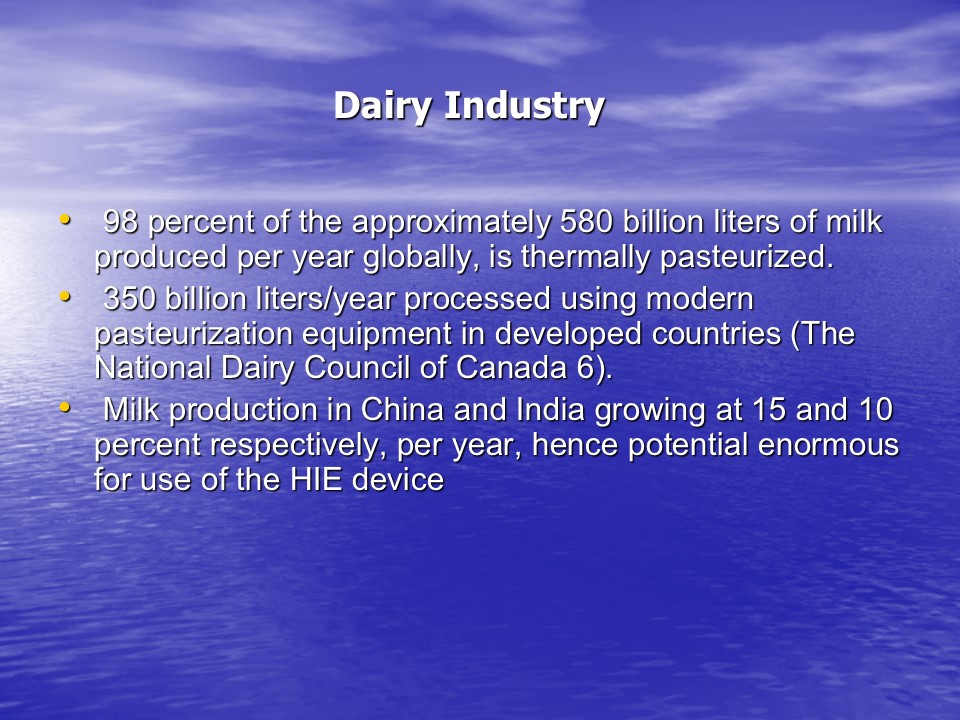
Pasteurization Process
- Before pasteurization, liquid milk stored at 4 °C.
- High temperature short time (HTST) pasteurization of milk uses hot water or steam, at 72 °C for 15 seconds.
- Plate & Frame or Shell & Tube heat exchangers used industrialized countries like Canada and the US.
- Chilled glycol fluids used to cool product to 4 °C.
- Media for transfer of heat is by complex and sophisticated network of hot water heaters, industrial boilers, cooling towers, refrigeration chillers, thermal switches, thermometers, and, timers.
- Counter-flow heat exchangers used to accomplish heat regeneration during pasteurization. Heat exchangers expensive, increases exponentially with increase in desired recovery level.
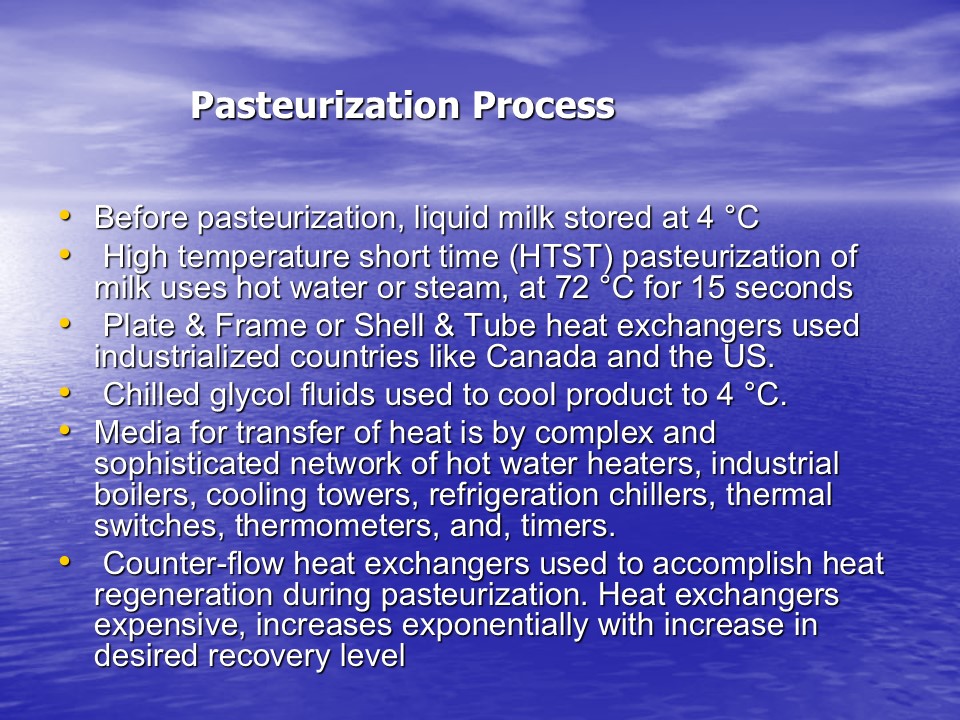
Pricing Strategies and Potential Profitability
- Profit maximization per unit- consolidation, replacement, and new market growth.
- Sales maximization- market opportunities expansion.
- Leasing- profitability and market size maximization. Clients to benefit from rebates on energy saved by using the new device.
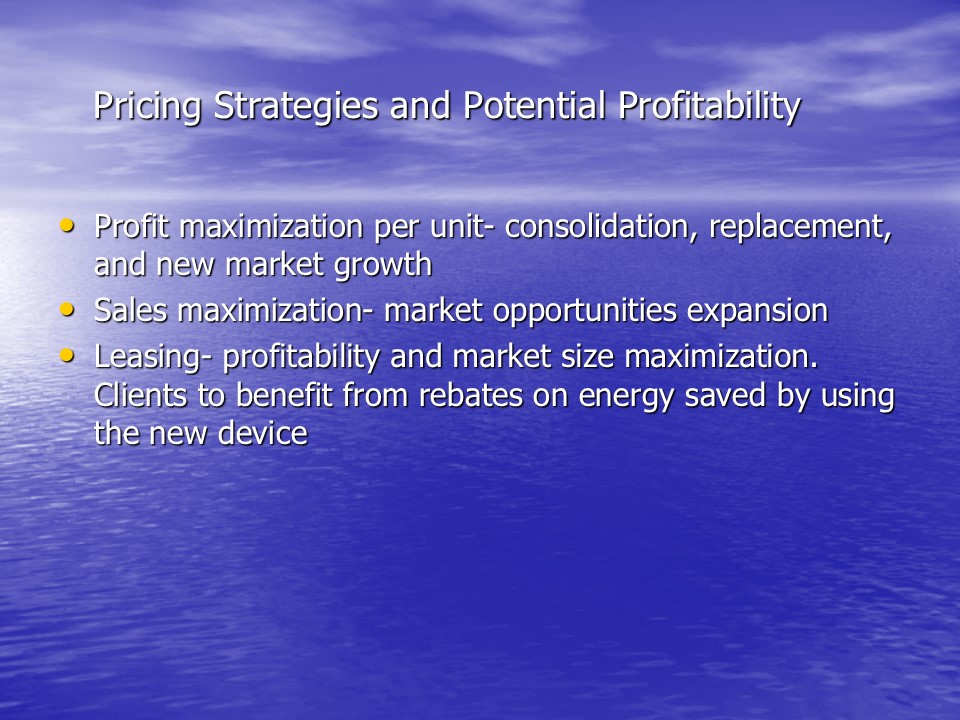
Company Development
- National Research Counsel of Canada already given a grant for the project.
- Working prototype and a good picture of market opportunity, to position MRT to raise funds either through private venture capital or creation of a public vehicle.
- Current MRT goal is the incorporation of insights gained from examination into development of a working prototype that will affect a 5-log reduction (equivalent to pasteurization) in bacteria for a single flow through process of liquid foods or water.
- Researching other market opportunities, such as industrial applications and potable water in order to quantify market size and penetration issues.
- Identification of potential key clients and strategic partners.
- Seeking alliances, and potential grant funding (university, government, industrial research entities) interested in this opportunity to complete designing, building, and testing for the working prototype.
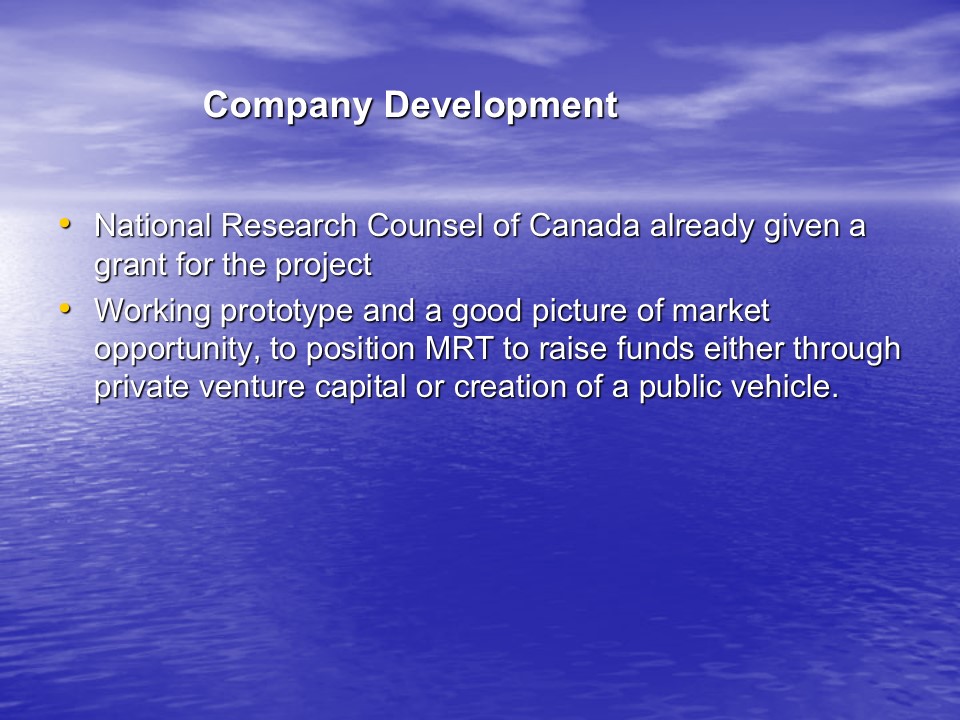
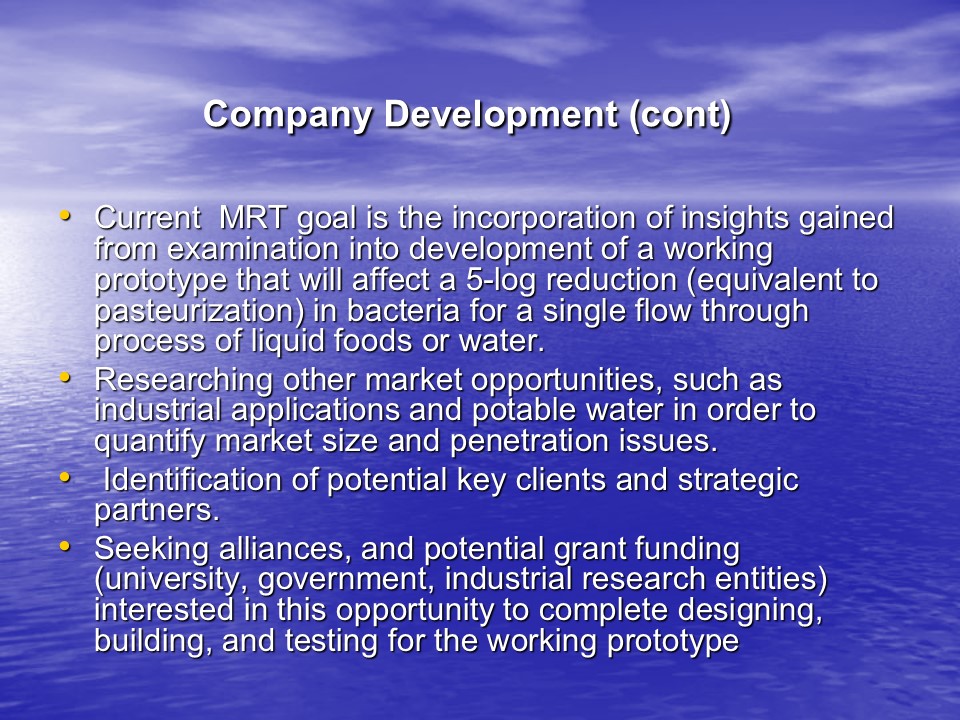
Work cited
The National Dairy Council of Canada. “Energy Performance Indicator Report: Fluid Milk Plants”. 2001. Web.